THE RENTERS OF CARROLL GARDENS (2017)
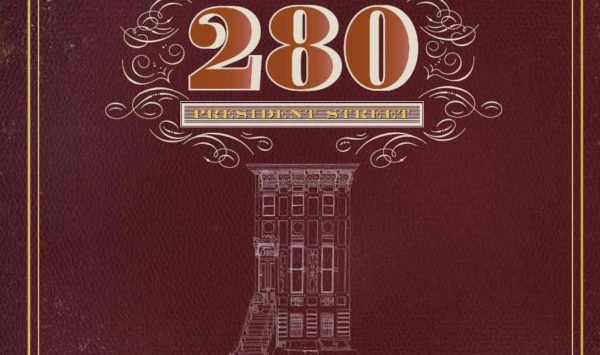
“A British cheese dealer, a newsman who predicted his own death, a leather merchant with a penchant for chorus girls, an alleged wife murderer, a German dentist with political aspirations, a Norwegian hero tugboat captain, and an Italian bomb builder…” These are many of the characters who were discovered during the recent investigation into the history of a Carroll Gardens brownstone. The historic property, No. 280 President Street, is an 1880 brownstone that was, additionally, built by a man who turned out to be the product of a clandestine relationship that rocked Brooklyn in the 1870s with stories of challenged wills, mental illness, and “other” women, presented under such headlines as “BEDEVILED” and “DRAKE’S WILL: His Illegitimate Children Most Carefully Provided for.” For nearly 100 years after the house was completed, No. 280 served its various owners as a rental property. The first owners to actually live in the home, Joachim and Eunice Auer, purchased it in 1979. After navigating redlining, remediating a rat and termite infestation, and entering into a year-long renovation, the Auers settled into enjoying their 2-story and basement home directly across the street from Carroll Park. While the Auers had always been interested in the history of their house (indeed, it was one of the reasons that they bought the house), and after doing some amount of research themselves, they decided to find someone who could more fully track down the history of their home. They turned to a detective – a Brownstone Detective. After a year […]
THE GREAT BROOKLYN FLOOD OF 1903
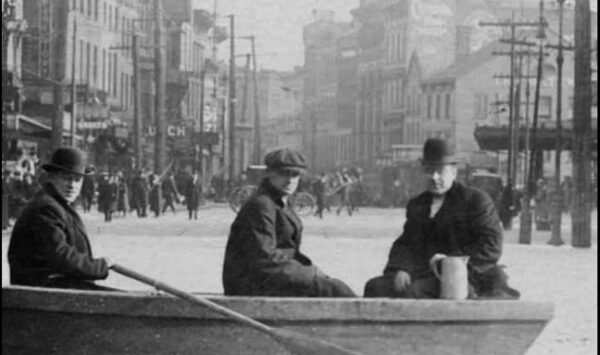
******************************************************************************************************************************** Brownstone Detectives investigates the history of our clients’ homes. The story you are about to read was composed from research conducted in the course of one of those investigations. Do you know the history of YOUR house? ******************************************************************************************************************************** By 7 a.m. on Friday, 9 October 1903, the cellars all along Macon Street were completely inundated with water that was rising quickly toward the basement joists. Without let up, the turgid brown waters continued to pour into the homes through the under-stoop doorways until the floodwaters had reached the level of the basement windowsills, whereupon it then began to pour also through the windows and into the basement dining rooms. The Ocean Hill area, like much of Brooklyn, had fallen victim of the heavy rains that had been falling continuously for much of the night. All the residences along Hancock, McDonough, Macon, Decatur, Bainbridge and Chauncey Streets were so flooded that residents on the ground floor apartments discovered upon waking that they were forced to go to the second floors to escape the waters. “IN SARATOGA PARK…BENCHES WERE FLOATING ABOUT…” The paths in Saratoga Park, according to one newspaper account, “had become running streams and benches were floating about.” The nearby Putnam and Halsey streetcars stopped running, as “it was impossible to take on any passengers, as the water was as high as the seats.” Streets and sidewalks were submerged under several inches of water, and, eventually, furniture moving vans were pressed into service by the police to be used […]
HOW A CENSUS-TAKER SAVED OUR BLOCK (1900)
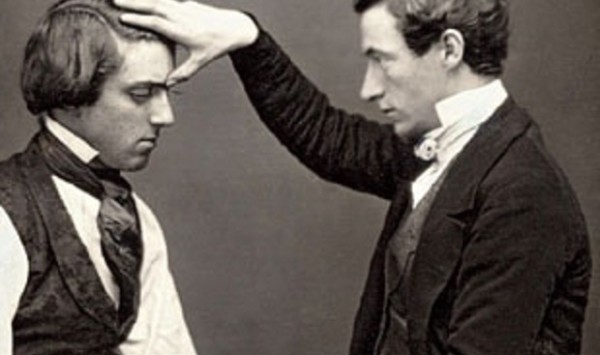
******************************************************************************************************************************** Brownstone Detectives investigates the history of our clients’ homes. The story you are about to read was composed from research conducted in the course of one of those investigations. Do you know the history of YOUR house? ******************************************************************************************************************************** I can tell you a little bit about every single family on my block. Well, not the present day families, of course – that might be a little creepy. Actually, it is a lot easier to extract such personal information about the families that lived on my block more than 100 years ago – in the year 1900. No, I am not a mesmerist or paranormal investigator. I don’t read cards or tea leaves. Nor do I make tables float or ask the spirit guides to knock in answer to my questions. I happen to use a less fantastic, more pedestrian source for this type of information for my answers. For, you see, I am a Brownstone Detective – and I use the 1900 Federal Census. I’M FROM THE FEDERAL GOVERNMENT AND I’M HERE TO HELP. The founders of our Federal government in the 18th century demanded that a decennial census be instituted. The demand was delineated within the U.S. Constitution, and the first attempt at listing Americans took place in 1790. The State of New York decided, too, that knowing who lived within its political boundaries was important. And so the state also began taking its own census in 1825. It was a decennial census, as well, which, in order […]
TO DENY A “COLORED” BLOCK PARTY (1920)
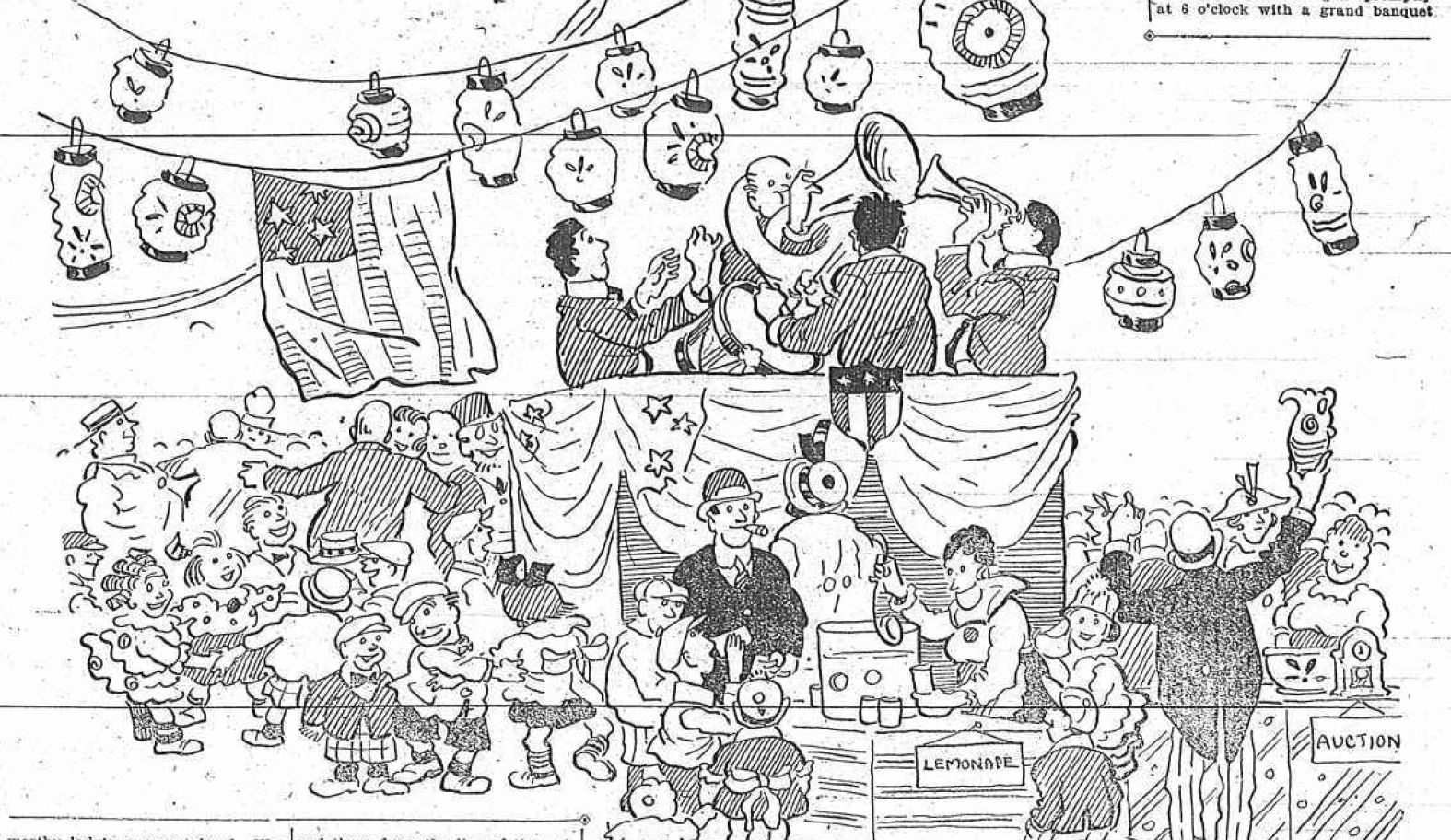
******************************************************************************************************************************** Brownstone Detectives investigates the history of our clients’ homes. The story you are about to read was composed from research conducted in the course of one of those investigations. Do you know the history of YOUR house? ******************************************************************************************************************************** Block party season upon us. It is a time of blocked-off streets, replete with the sounds of children happily playing, the smells of barbecues up and down the block, and carefree feelings of the beginning of summer. But this is also a time to remember some freedoms that were not always available to certain citizens – those freedoms for which struggles were necessary that they may be obtained. As such, it is instructive to remember how one group of people was often at the mercy of the whims of another. This story tells a tale that took place in 1920 when block party permits were not always so easy to obtain, particularly when the freedoms of those in the minority were proscribed by those in the majority… THE TRICKLE STARTS… In the mid-1930s, after the “A Train” had been extended into Brooklyn, African-Americans began to move in large numbers from Harlem into Bedford-Stuyvesant. Although the Eighth Avenue Express was the vehicle for that migration, the impetus was a desire for less crowded neighborhoods, more plentiful jobs (at the Brooklyn Navy Yard), and better housing conditions. The trickle that started this migration, though, began about 10 to 20 years earlier as African-American professionals of southern and Caribbean descent made their way to […]
THE DAY RIOTERS STORMED BROOKLYN (1895)
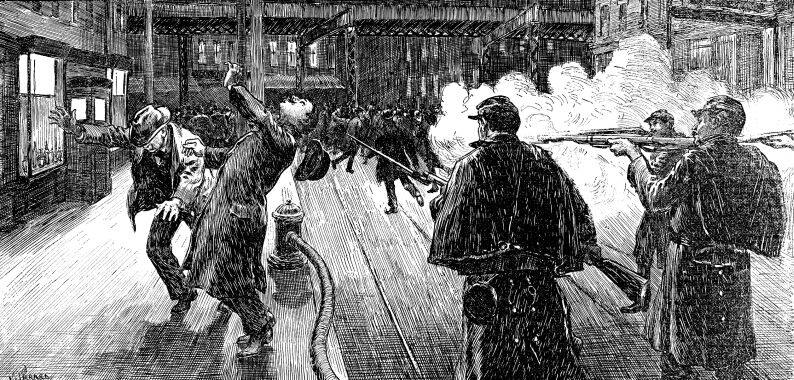
******************************************************************************************************************************** Brownstone Detectives investigates the history of our clients’ homes. The story you are about to read was composed from research conducted in the course of one of those investigations. Do you know the history of YOUR house? ******************************************************************************************************************************** (The above picture shows the New York State militia shooting a man on Halsey Street, near the corner of Broadway. You can see the recently erected elevated train line at the end of the block.) In 1895, Halsey Street near Saratoga Park had become a war zone. The Brooklyn Streetcar strike had begun on 15 January, and before the week was over the agitation would be in full force. The strike, which began with a walkout, would quickly devolve into a pitched battle between the Knights of Labor and streetcar workers on one side and the streetcar line owners, the police and the New York State Militia on the other. The main focus of much of the strikers’ attention in this part of Brooklyn, though, was the Halsey Street Rail Road Barns. These, located near the corner of Halsey Street and Broadway, were where the streetcar line stored its cars, quartered its horses, and from whence the line’s streetcars were dispatched. After the workers had called the strike, 5,500 of them would walk off the job for better conditions. The streetcar line owners (the lines were privately owned and operated at the time) countered this strike by calling in scabs who would attempt to operate the streetcars in the workers’ absence. […]
THE “7-SECOND MAN” OF BED-STUY (1918)
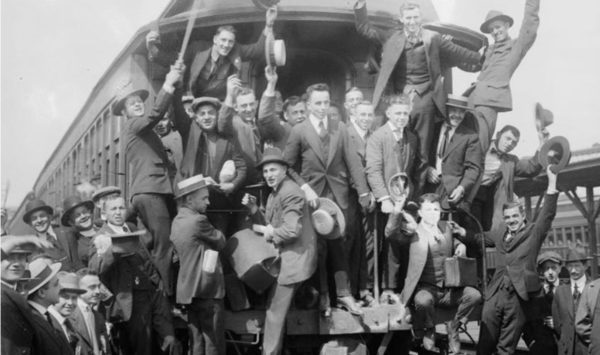
******************************************************************************************************************************** Brownstone Detectives investigates the history of our clients’ homes. The story you are about to read was composed from research conducted in the course of one of those investigations. Do you know the history of YOUR house? ******************************************************************************************************************************** The new “Victory and Peace” war memorial at Saratoga Park, located in the Stuyvesant East section of Brooklyn, was the subject of a public dedication on 10 September 2014. The Brownstone Detectives worked closely with the Parks Department by locating pictures, stories, and relatives of the Stuyvesant Heights men who gave their lives in the Great War. This biography is about one of those men. PRIVATE EDWARD J. BELL In 1920, as the “War to End All Wars” was still fresh on America’s collective conscious, American Legion posts were sprouting up everywhere. The trend existed for two reasons: to support the men who had come back from the front, and to memorialize those who never returned. Many of the posts were named after those who had made the ultimate sacrifice. The Edward J. Bell Post No. 790 had recently been formed to honor Edward Joseph “Eddie” Bell, a 25-year-old machine-gunner, and Purple Heart winner, who died in France on 16 August 1918, from the result of injuries sustained in combat. Born on 6 November 1892, Bell had lived with his father, his aunt and his grandparents at 735 Macon Street. Sometime around 1910, the tall, black-haired, and blue-eyed Bell had graduated from Commercial High School, and soon thereafter lost his father. […]
ARRESTED FOR SELLING BICYCLE OIL (1896)
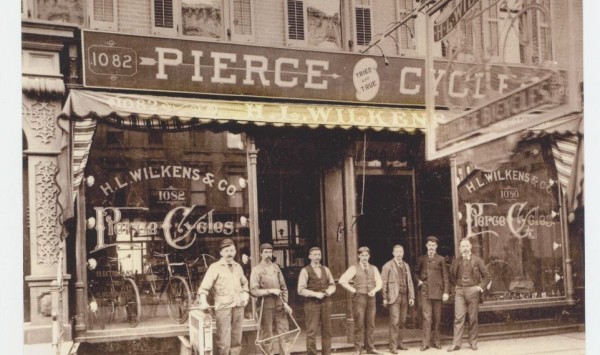
******************************************************************************************************************************** Brownstone Detectives investigates the history of our clients’ homes. The story you are about to read was composed from research conducted in the course of one of those investigations. Do you know the history of YOUR house? ******************************************************************************************************************************** In 1896, bicycling was so enormously popular that Brooklynites were being arrested for it. So much so that “wheel” shops made it a practice on Bedford Avenue to stay open on Sundays in open violation of the “Sunday law” which prevented businesses from operating on that day. In April of that year, Detective Brady of the Fourth Precinct was sent on a mission to do something about this infringement upon decent society. Churchgoers living in the Bedford Avenue section – the primary bicycling route back then – were the most vocal complainers, informing the police that, at 1082 Bedford Avenue in particular, not only “are goods disposed of, but that the repairing department of some of these establishments are in full blast all day Sunday, and workmen are kept busy fixing up disabled wheels.” Armed with this information, Brady took a Sunday trip down the busy avenue – perhaps on his bicycle, to ensure he played well the part of the wheelman – to investigate. Arriving at the address in question, he “found the store of H.L. Wilkens & Co., at 1082 Bedford avenue, open and business being carried on.” Approaching a worker at the store, in order to have evidence against the establishment, Brady purchased a bottle of bicycle oil. […]
PVT. EDWIN RUOFF (A BEDSTUY HERO) (1918)
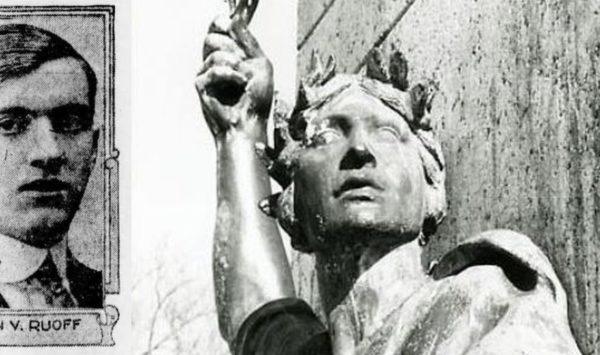
******************************************************************************************************************************** Brownstone Detectives investigates the history of our clients’ homes. The story you are about to read was composed from research conducted in the course of one of those investigations. Do you know the history of YOUR house? ******************************************************************************************************************************** In 2014, The Brownstone Detectives partnered with the New York City Parks Department to help celebrate the lives of the servicemembers of Bedford-Stuyvesant Heights who made the ultimate sacrifice during the Great War. We researched these heroes to locate pictures, stories, and their descendants to be brought together for a ceremony that dedicated a new “Victory and Peace” war memorial at Saratoga Park. This biography tells the story of one of those servicemembers. PVT. EDWIN V. RUOFF Before being drafted into the U.S. Army to fight in the Great War, Private Edwin V. Ruoff was a resident of Stuyvesant Heights where he lived at 193 Ralph Avenue. He was killed in an accidental bomb explosion on 3 June 1918 in France, when a supposedly harmless shell went off. The explosion, which took the lives of 45 soldiers in total, occurred when the company was drilling. It all started when one of the men discovered the “bomb or hand grenade” and “began fooling with it.” Then, “after tossing it about and whirling it around, he let it drop. As the missile hit the ground, there was a terrific explosion, the force of which threw almost every member of the company to the ground.” THE ARMY VISITS MRS. RUOFF According to the Brooklyn […]
“BLOWN TO PIECES” ON MACON STREET (1916)
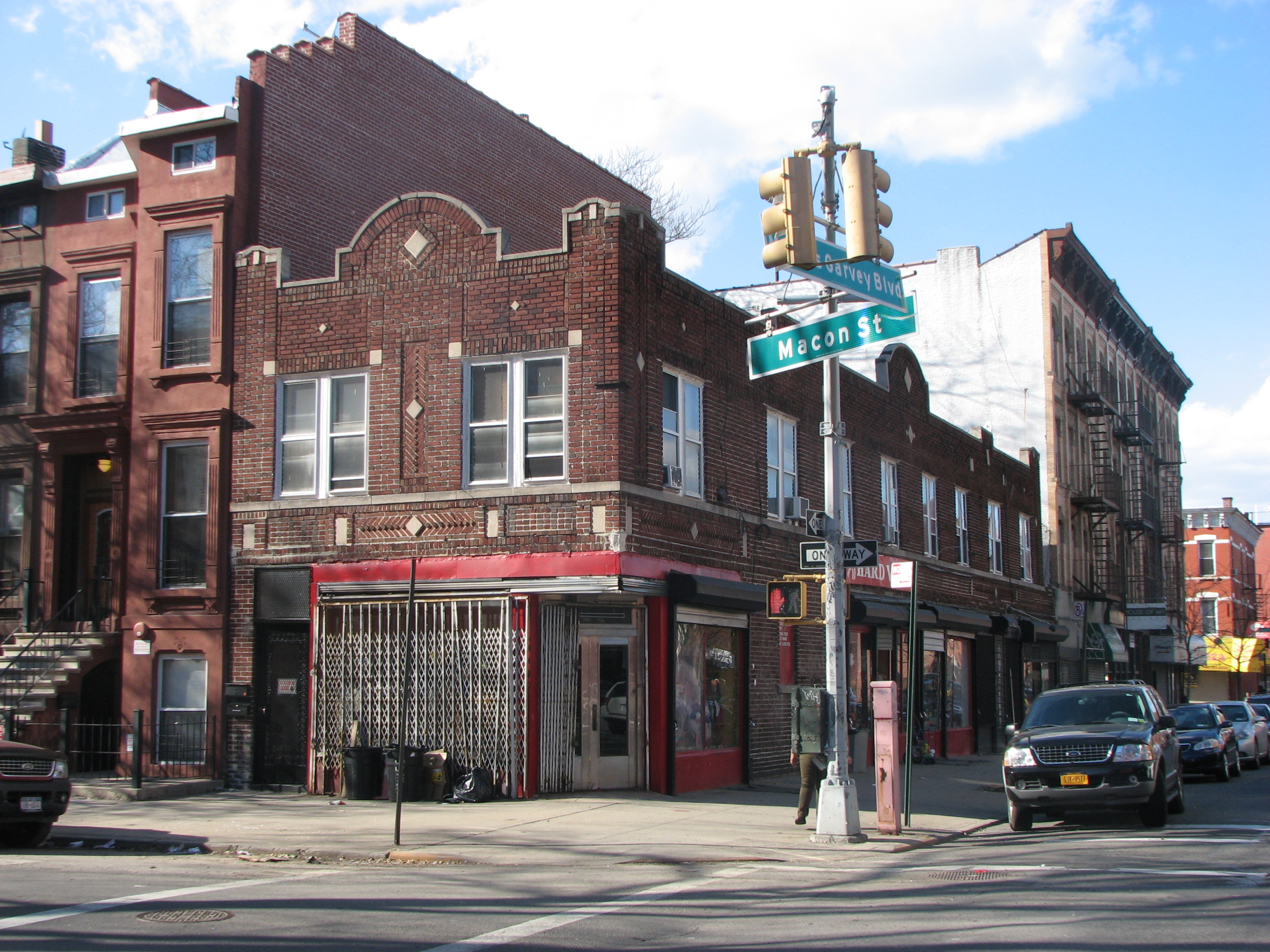
******************************************************************************************************************************** Brownstone Detectives investigates the history of our clients’ homes. The story you are about to read was composed from research conducted in the course of one of those investigations. Do you know the history of YOUR house? ******************************************************************************************************************************** On a warm summer morning in 1916, five people were killed and “more than a score were injured” when a masonry building on Macon Street was “blown to pieces” in a gas “explosion” occurring shortly after most of the building’s inhabitants had left for work for the day. Authorities were still attempting to determine who may have been in the building at the time of the blast, but the source of the explosion was believed to be a gas leak from the cellar of the building. THAT WAS THEN, THIS IS NOW This story was written more than 100 years ago, in 1916. The explosion, which fractured many Brooklyn lives, took place in the middle of Stuyvesant Heights at the corner of Macon Street and Sumner Avenue (now Marcus Garvey). Similar in detail to the East Village gas explosion of a few years back, only the time and place has changed. Both the buildings were residential with stores on the ground levels, and the 1916 explosion, itself, was also caused by a gas leak. Apparently, gas leaks have been leveling buildings since buildings were being plumbed with the element. In 2015’s explosion, the gas in the building was used for heating the apartments and the building’s water. In 1916, the gas […]
INSIDE SUMNER ARMORY – BASEBALL! (1895)
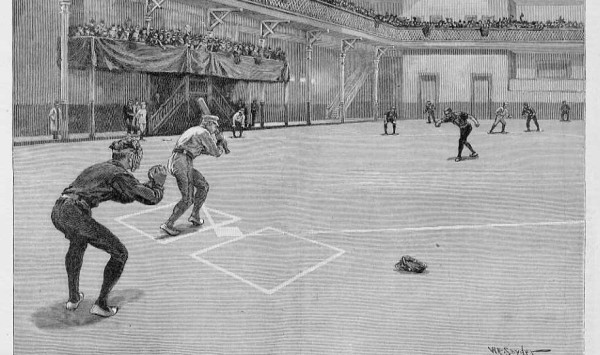
******************************************************************************************************************************** Brownstone Detectives investigates the history of our clients’ homes. The story you are about to read was composed from research conducted in the course of one of those investigations. Do you know the history of YOUR house? ******************************************************************************************************************************** Back in the day, in addition to drilling the troops, our national guard reserve units used to utilize our armories the way we all hope they’ll be used again one day – for exercise and fitness. Here at the 13th Regiment Armory (formerly known as the Sumner Armory on Sumner Avenue [now known as Marcus Garvey Boulevard] between Jefferson and Putnam Avenues), a number of the men chose up sides and played a game of baseball – inside. By the mid 1870s, “baseball already was popular in most big eastern cities and remained so throughout the nineteenth century,” noted “The Great Encyclopedia of Nineteenth-Century Major League Baseball” By David Nemec. “The ball was softer, the fielders never wore gloves, the bases were closer together and sliding was taboo–otherwise spectators saw much the same display of skills they did during the outdoor season.” Views of the armory (which was built in 1891, according to Save Bedford-Stuyvesant, in order to replace an armory in Flatbush) from the outside are all too easy to come by. But shots like these (drawings, rather), depicting the layout of the structure from the inside, appear much less often. Originally, according to the New York Times, “(i)nside the headhouse, the administrative section at the front of the armory, […]